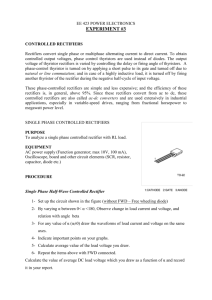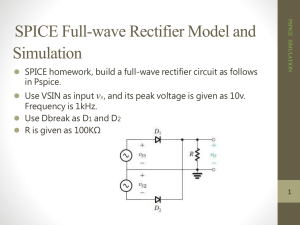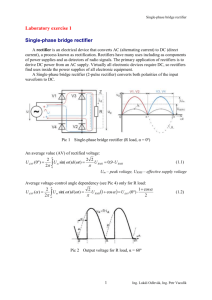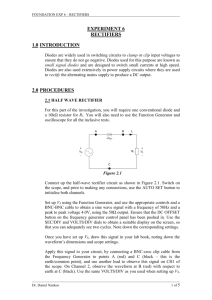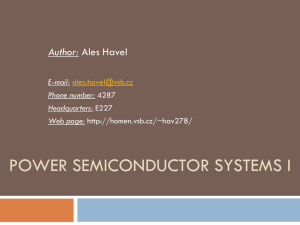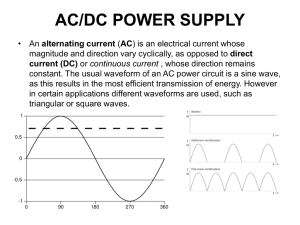File
advertisement
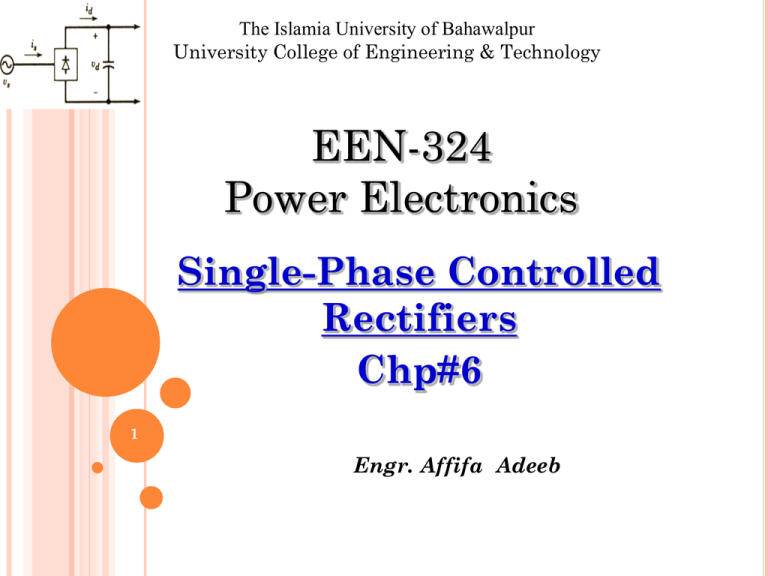
The Islamia University of Bahawalpur University College of Engineering & Technology EEN-324 Power Electronics Single-Phase Controlled Rectifiers Chp#6 1 Engr. Affifa Adeeb INTRODUCTION Diodes of rectifier circuits in chp5 are replaced by thyristors. In thyristor based rectifiers, output voltage can be controlled. So they are termed as controlled rectifiers. Controlled rectifiers produce variable DC output, whose magnitude is varied by Phase control. Phase Control DC output from rectifier is controlled by controlling duration of the conduction period by varying the point at which gate signal is applied to SCR. Main drawback of phase control is Radio Frequency Interference (RFI) 2 Controlled rectifiers are of two types, 1- Fully Controlled rectifiers DC current is unidirectional, but DC voltage has either polarity. With one polarity, flow of power is from AC source to DC load---Rectification. With the reversal of DC voltage by the load, flow of power is from DC load to AC source---Inversion. 2- Half controlled rectifiers Half of SCRs are replaced by diodes. DC output current and voltage are unidirectional. i.e., flow of power is from AC source to DC load. 3 HALF-WAVE CONTROLLED RECTIFIERS 4 With Resistive Load 5 Control characteristics of half-wave rectifier 6 With an Inductive (RL) Load 7 With Inductive Load and Freewheeling Diode 8 FULL-WAVE CONTROLLED CENTERTAP RECTIFIERS 9 With Resistive Load 10 With an Inductive (RL) Load 11 Control Characteristics for center-tap rectifier 12 With Freewheeling Diode 13 EXAMPLE 6.4 Explain with the help of waveforms the operation of a full-wave center-tap rectifier with RL load for the following firing angles: (a) 0° (b) 45° (c) 90° (d) 135° (e) 180° Assume highly Inductive Load 14 Voltage and current waveforms for α=0° During positive-half cycle of source voltage, SCR1 is forward biased and SCR2 is reverse biased. During negative halfcycle, SCR2 is forward biased and SCR1 is reverse biased. In either case voltage across the load is Vs. Output is similar to uncontrolled rectifier. Each SCR conducts for 180° and supplies current to the load for this period 15 Voltage and current waveforms for α=45° Average DC output voltage decreases. If SCR1 is triggered at 45°, SCR2 will conduct upto that point, even though the source voltage is zero, due to highly inductive nature of load. When SCR1 is turned on, SCR2 is turned off. Current to the load is supplied by SCR1 and SCR2, each conducting for 180° 16 Voltage and current waveforms for α=90° Average DC voltage is zero, so there is no transfer of power from AC source to DC load. Each SCR remains in conduction for 180° As firing angle is increased from 0 to 90°, the power supplied to the DC load decreases, becoming zero at α=90° 17 Voltage and current waveforms for α=135° Average DC voltage is negative. Load current still flows in each SCR for 180° in its original direction. Load voltage has changed polarity. Power now flows from DC load to AC source . Circuit acts like an inverter. 18 Voltage and current waveforms for α=180° Average output DC voltage is at its maximum negative value. SCRs remain in conduction for 180° 19 EXAMPLE 6.5 Show direction of power flow and operating mode (rectifying or inversion) of center-tap rectifier circuit with following firing angles: A) α > 0° B) α < 90° C) α > 90° D) α < 180° 20 SOLUTION For firing angle in the range 0° < α < 90° 1. Average output voltage is positive. 2. Converter operates in the rectifying mode. 3. Power to the load is positive 4. Power flow is from AC source to the DC load. For firing angle in the range 90° < α < 180° 1. Average output voltage is negative 2. Converter operates in inversion mode 3. Power to the load is negative 4. Power flow is from DC load to AC source 21 ASSIGNMENT # 2 In example 6.4, draw waveforms for voltage across thyristor 2. i.e., VSCR2 22 FULL-WAVE CONTROLLED BRIDGE RECTIFIER 23 With Resistive Load 24 With an Inductive (RL) Load 25 For L >>> R 26 Control characteristics for bridge rectifier 27 With RL load and freewheeling diode 28 HALF-CONTROLLED OR SEMICONTROLLED BRIDGE RECTIFIERS 29 In fully-controlled rectifier, only rectification can be obtained by connecting a freewheeling diode across the output terminals of the rectifier. Another method of obtaining rectification in bridge rectifiers is replacing half of the SCRs with diodes. These circuits are called semicontrolled bridge rectifiers. 30 Full-wave semicontrolled bridge rectifier circuit 31 Semicontrolled bridge rectifier with FWD 32 DUAL CONVERTER 33 Exercise Problems 6.1, 6.5, 6.6, 6.9, 6.12, 6.21, 6.22, 6.24 Also give analysis of waveforms in each case of all above exercise problems
